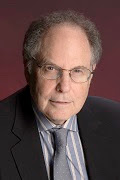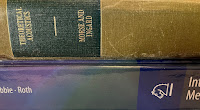Exponential growth cannot go on forever. This fact is often ignored by economists and politicians. Albert Bartlett has written extensively on this subject. You can find several references in The American Journal of Physics and The Physics Teacher. See the summary in Bartlett (2004).
 |
| The Essential Exponential! by Albert Bartlett. |
Bartlett A (2004) The Essential Exponential! For the Future of our Planet. Center for Science, Mathematics & Computer Education, LincolnTo celebrate Bartlett’s life, I’ll quote excerpts from an interview with Paul Nachman in May, 2005.
I started as an undergraduate in the fall of 1940 at Otterbein College in Westerville, Ohio. (It's a small, church-founded school, and my father was a Professor of Education there. Westerville back then was a separate town north of Columbus. Now it's been engulfed by Columbus.) In the spring of 1941, I was looking for some adventure, so I got a summer job washing dishes on an iron ore freighter on the Great Lakes. It took me several hitchhiking trips to Cleveland to get all the federal papers you need to work on the ships…Fortunately for all of us, Bartlett returned to college.
When September came along, I was having a good time, making good money, so I didn’t return to school. And that fall was Pearl Harbor. We were unloading the last cargo of iron ore for the season at the Wickwire-Spencer steel mill in Tonawanda, New York, on December 7. I’d finished cleaning up after lunch, then gone to my room and turned on the radio. I was the first person on board to hear the report...
I said to myself, “I need to get back to college.” Writing from the boat, I applied to transfer to Colgate University in upstate New York. I was accepted, so, coming into Cleveland one day, I told the steward I was leaving to go back to college. I hitchhiked back to my home, changed from shipboard clothes to college clothes, hitchhiked up to Hamilton, New York, and started there in the fall semester of 1942.Bartlett studied physics and math, and graduated from Colgate in 1944. Listen to how he ended up working on the Manhattan Project.
One of my professors heard that there was an address, “Box 1663,” in Santa Fe, New Mexico, where they were hiring physicists. Sounded like adventure to me, so I applied. Didn’t know what it was, and they didn't tell me and I was accepted.
My only instructions were to appear at 109 E. Palace in Santa Fe. So, after graduation, I hitchhiked home to Ohio, and to Springfield where a friend helped me get two new International Harvester trucks from the factory. I drove them to a dealer in Oklahoma City and then hitchhiked to Amarillo. All my life I’d wanted to ride a freight train, so I hopped a freight in Amarillo to Belen, south of Albuquerque. Then I hitchhiked to Santa Fe and reported to 109 E. Palace. The lady there in the office was Dorothy McKibben. She did some paperwork and had me get on an Army bus in the alley in back. It took me off through the desert and canyons up to Los Alamos. Quite an experience! I arrived on July 18, 1944 and worked for 25 months there.”At Los Alamos he worked on mass spectrometry of plutonium.
It wasn’t that I knew anything about mass spectrometry, but this was just at a time when the first plutonium was coming down from Hanford, and there was some indication that, in addition to the principal isotope 239Pu, there may be some 240Pu from an extra neutron capture in the Hanford reactors.In 1946 he went to Harvard for graduate study in physics. His PhD project was to build
Now 240Pu has a high spontaneous fission probability, which would upset all their [bomb] calculations. So they wanted to know how much was there. They’d just requisitioned a mass spectrometer from a lab in Washington, DC, about the time I got there, and Bob Thompson, who’d been a PhD student with Al Nier at Minnesota, was setting it up. Bob took me on me sort of as an apprentice and took a real interest in me, telling me what I needed to study, giving me a stack of reprints to read, etc. He was very helpful. So we made the first measurements of the isotopic constitution of plutonium coming out of the reactors.
… a beta-ray [electron] spectrometer. I finished at Harvard and came out to Colorado in the late summer of 1950. I’ve been here ever since.By Colorado, he meant the University of Colorado in Boulder. I interviewed at Boulder for graduate school around 1982. I can’t remember if I met Bartlett. I hope I did.
Bartlett was primarily focused on physics education. He was a leader in the American Association of Physics Teachers.
In 1978, I was national President of the American Association of Physics Teachers [AAPT]. I had four years in the AAPT presidential sequence vice-president, president-elect, president, and past president with duties in each of those offices. In ’78 I was the President, so I was quite involved with physics education, and I think that was why I was named an APS Fellow.Bartlett is best known for his talk on exponential growth and the environment, which he gave over 1700 times (watch in on the YouTube videos below). Here is how it all got started.
Well, during all the uprising on the campus, there was a surge of student interest in the environment, and I had been slowly coming to the realization that students and other people didn’t have an understanding of the arithmetic of compound interest. So I started putting some notes together, and in September of 1969 the undergraduate pre-med honor society asked if I could speak on something or other at one of their meetings. I’d known many of these kids from the previous year when I was lecturing in the pre-med beginning physics course, so I put these notes together and on September 19, 1969 talked to them about growth and the problems of growth.With climate change becoming the major environmental issue of our time, we must all remember Bartlett’s famous quote:
It didn’t have anything like the scope of today’s presentation. But, fortunately, I kept my notes and the next year I had two or three more invitations. It evolved as I became more interested. Finally in '78 or '79, I gave the talk 131 times. It was sort of like a Hubbert peak! It went down after that, but instead of going to zero, it’s leveled off at about 40 times a year.
The greatest shortcoming of the human race is our inability to understand the exponential function.
This inability is all the more reason to study Chapter 2 in IPMB, about exponential growth and decay. The survival of our species may depend on us somehow learning to understand exponential growth and its limitations.
A final reason to celebrate Bartlett is that this year, 2023, is the 100th anniversary of his birth: March 21, 1923. Happy 100th birthday, Albert Bartlett. We need you now more than ever!
The Most Important Video You Will Ever See (Part 2)
The Most Important Video You Will Ever See (Part 4)






















